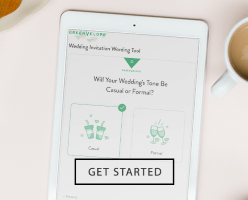Invites 101: How to Address Wedding Invitations
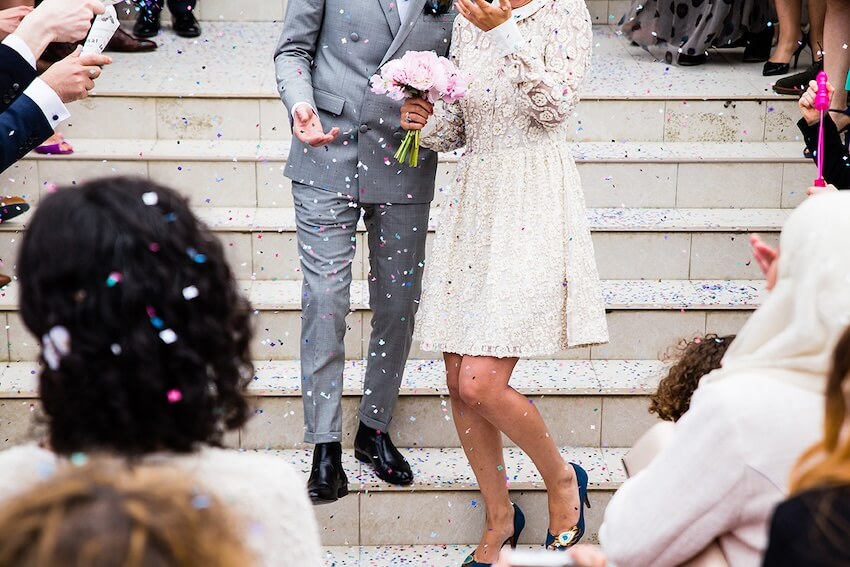
It’s just a few months until the big day. The bridal party is chosen, the menu selected, and the cake taste-tested. Now is the time to send out the invitations — but how does one address wedding invitations? Don’t worry — this is our forte.
There is a formal way to address wedding invitations, and we’re happy to walk you through it. The questions may already be bubbling up in your own mind: Whose name should you write first? How do you tell single guests whether they’re welcome to bring a plus one? How do you invite a whole family?
All of these questions — and probably a few others — are about to be answered. But before you write the addresses for each person on your guest list, we’ll talk about envelopes. Envelope addressing is trickier than you may think, because there are two if you’re sending paper invites, and what you write on each one is a little different.
After we clear that up — or if you’re sending digital invites — you can hop to the section where we cover how to address wedding invitations and offer examples of what to include.
Invitation Etiquette: Addressing Wedding Invitation Envelopes

Design: Jen Montgomery
When sending out wedding invitations, unless you’re sending one virtually, there are two envelopes: an inner envelope and an outer envelope. If you do choose to send digital invitations (and save plenty of paper in the process!), we’ll address that further down in this post.
The Outer Envelope for MailingÂ
The outer envelope is where you print a guest’s physical address. This is the envelope handled by your mail courier. You’ll type (or hand write, if you’re feeling ambitious) your guests’ names on the first line, complete with proper titles, first names, and last names (middle names are optional). While you can abbreviate a title, you should spell out first names.
Next, write the physical address of your guests’ home or post office box. Again, use full words here (no abbreviations) writing Street instead of St., Road instead of Rd., and so on.
The Inner Envelope for InvitingÂ
Within the inner envelope, your guests will find the invitation suite. Each guest invited to the wedding will have their names printed on this envelope. Except this time, you just need to print titles and last names.
Take note: This is your opportunity to be very specific about who is invited to your wedding. If you are welcoming plus ones, you will allude to that here (more on this below). If you’re inviting two people, both their names should be printed.
Now that you have the envelopes sorted out, it’s time to address your invitations. But how does one do this? Below, you’ll learn exactly how to address each envelope, depending on your guests’ names, titles, and relationships to one another.
Digital Invites With One Envelope
Finally, what happens if your wedding invitations only have one envelope? With online invitations from Greenvelope, you’ll skip the post office line and conveniently send your wedding invitations directly to your guests’ inboxes.Â
There will only be one envelope, so you’ll typically use the “outer envelope” standards, with two exceptions:Â
- Be sure to list every guest’s name, including children and those who live in different households.
- Include “And Guest” on the envelope for those who are allowed to bring a plus one.
How to Address Wedding Invitations: Examples
Looking for examples before you address and write your wedding invitations? Here, you’ll find several options for how to address wedding invitations, all guided by proper wedding etiquette rules.Â
In addition to these tips on addressing the envelope, be sure to include the correct mailing address and your return address.
1. How to Address a Wedding Invite to a Married Couple With the Same Last Name
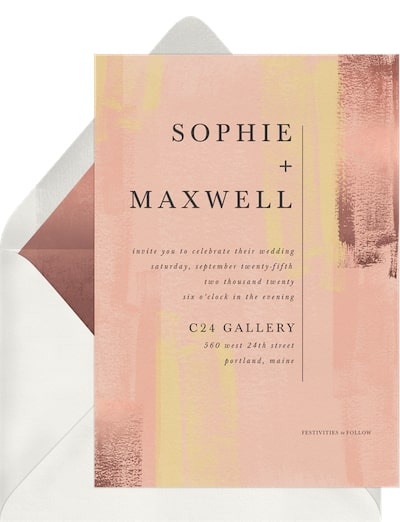
Design: TM Stationery
For married couples with the same last name, you have a few options.
Heterosexual CouplesÂ
The traditional approach for formal invitations is to write both the husband and wife’s titles on the outer envelope, in addition to the husband’s name (first and last). On the inner envelope, you’ll write just the couple’s title and collective last name.Â
With heterosexual couples, it’s customary for the male’s name to be written first. This is just a tradition, and we encourage you to address envelopes in whichever way you see fit.
If you take this approach, your envelopes will look like this:
Outer envelope:
Mr. and Mrs. Thomas Portz
Inner envelope:
Mr. and Mrs. Portz
Some women appreciate their full names being printed. If you anticipate your guest wishing to be addressed this way, print the woman’s name alongside her husband’s.
Outer envelope:
Mr. Thomas Portz and Mrs. Karen Portz
Inner envelope:
Mr. and Mrs. Portz
(You could also simply write “Thomas and Karen,” “Mr. & Mrs. Portz,” or their nicknames if you’d prefer a more casual tone.)
Same-Sex Couples
With same-sex couples, you can write their names in alphabetical order, such as:
Outer envelope:
Mrs. Kira Gonzalez-Strong and Mrs. Sarah Gonzalez-Strong
Inner envelope:
Mrs. and Mrs. Gonzalez-Strong (or Kira and Sarah)
2. How to Address a Wedding Invite to Married Couple With Different Last NamesÂ
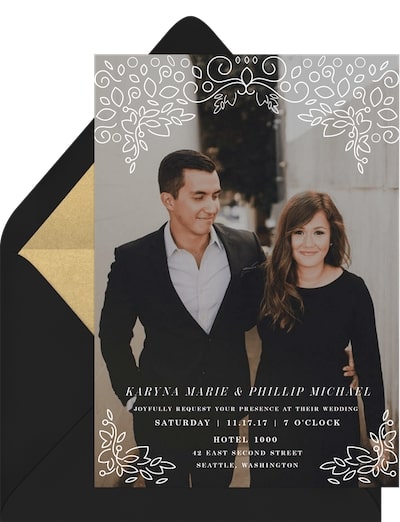
Design: Robinson Creative House
If you have guests who are married but share different last names, there’s a bit of discrepancy as to whose name should be written first. Some believe that ladies go first (the opposite of the above scenario). Others state that you should write them in alphabetical order, while still others believe the guest you’re closest to should be written first.
Since there are so many rules, we say choose whatever you want.
An example of this scenario would be:
Outer envelope:
Mrs. Cristina Anderson and Mr. Ben McCartney
Inner envelope:
Mrs. Anderson and Mr. McCartney (or Cristina and Ben)
3. How to Address a Wedding Invite to Unmarried CouplesÂ
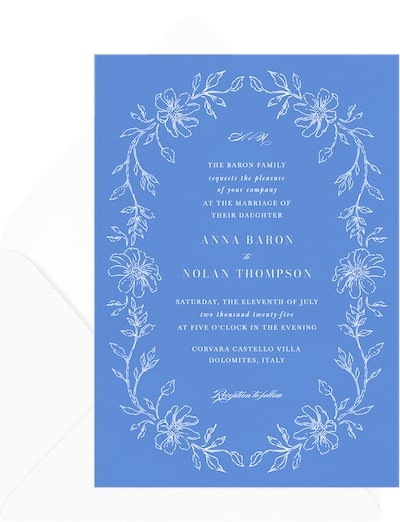
Design: Stellax Creative
If a couple is not married, it’s customary to write their names on two separate lines. For an unmarried couple living together, you will write their names in alphabetical order. For example, you’ll write:
Outer envelope:
Miss (or Ms.) Stephanie Belitz
Miss (or Ms.) Katie Foster
Inner envelope:
Miss (or Ms.) Belitz
Miss (or Ms.) Foster
On the other hand, if the couple does not live together, you will send the invitation to the guest you’re closest to. Their name will be the only one listed on the outer envelope. So this scenario will look like this:
Outer envelope:
Miss (or Ms.) Megan Peterman
Inner envelope:
Miss (or Ms.) Peterman
Mr. Jacobsen
4. How to Address a Wedding Invite to Single Guests
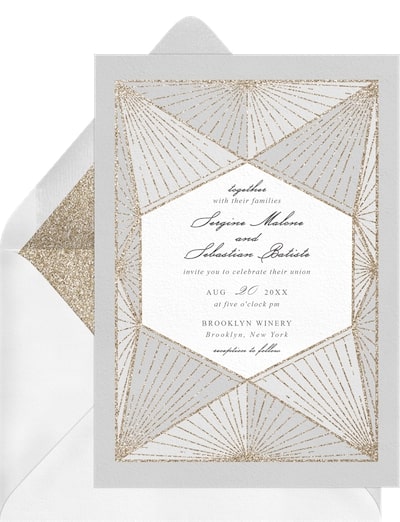
Design: Ana Sharpe Design
If your guests are single, you will write their full name and title on the outer envelope. If you are welcoming a plus one, you will write their name with “and Guest” on the inner envelope. It would look like:
Outer envelope:
Mr. Ari Black
Inner envelope:
Mr. Black (and Guest)
If your guest is a formerly married woman, her title will change depending on whether she returned to her maiden name. If she kept her married name, you would address her as “Mrs. Carole McCarthy.” However, if she returned to her maiden name, you would write, “Miss Carole Perrin.”Â
5. How to Address a Wedding Invite to a Family
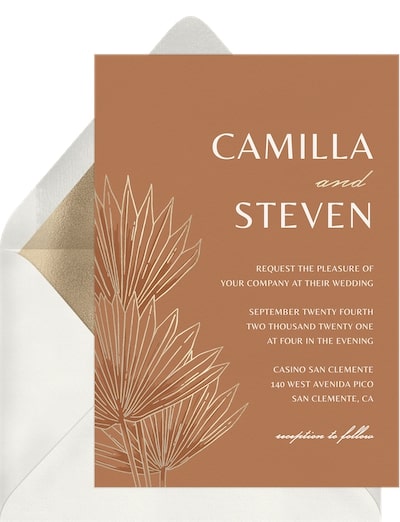
Design: Signature Greenvelope
When addressing your wedding invite to a family, you include only the name of the parents or guardians on the outer envelope. On the inner envelope, you’ll list the name of each child on the same line underneath the parent’s or guardian’s names. Use a title like Miss for young ladies under 18 years old, but only use the title “Mr.” for young men who are 16 years of age or older.
Outer envelope:
Mr. and Mrs. Garren Thompson
Inner envelope:
Mr. and Mrs. Garren Thompson
Miss Cecilia, Mx Coco, Miss Jane, and Daniel
Per etiquette rules, if you don’t list the children’s names, then they are not invited and it is an adults-only invite. This can be confusing to many guests so it’s a good idea to include this information on your RSVP card and wedding website as well.
If you’re having a big wedding with a “the more the merrier” vibe, you may want to invite guests to bring along their entire family. Here’s how you can do that:
Outer envelope:
Mr. John Smith
Inner envelope:
Mr. John Smith and family members
Just note, you may get more than you bargained for with this approach and it will be harder to get a final headcount or stay within budget. However, for more casual gatherings like a boho reception where food won’t be served, this can be a fun way to include everyone without breaking the bank.
6. How to Address a Wedding Invite to Children Over 18
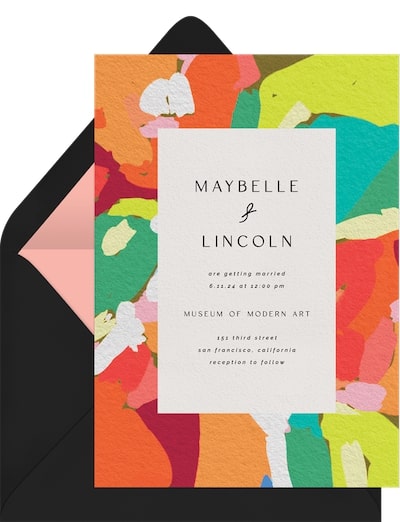
Design: See That There
If children are invited to your wedding, you will simply write each of the children’s names (first only) underneath their parents’ names, from oldest to youngest. If, however, the child is over the age of 18 (even if they still live with their parents), they should receive their own invitation. To include the entire family on an invite, you would write:
Outer envelope:
Mr. and Mrs. Chris Thompson
Inner envelope:
Mr. and Mrs. Thompson
Mr. Nathan, Mr. James, and Bella
7. How to Address a Wedding Invite to People With Professional TitlesÂ
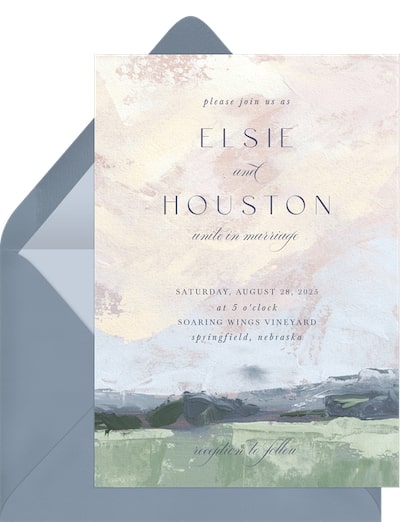
Design: Holly Whitcomb
If one of your guests is a doctor, judge, pastor, or military personnel, their respective invitation should reflect their distinguished titles and honorifics. If each guest within a couple has a title, and the two combined names and titles don’t fit on one line, it is customary to indent the second line. Some examples include:
Outer envelope:
Dr. Abby and Mr. Tom Baker
Inner envelope:
Dr. Baker and Mr. Baker
You could also use a format like this:
Outer envelope:
Captain Juliana Frye
Lieutenant Steven Bryant
Inner envelope:
Captain Frye
Lieutenant Bryant
On Your Day, You Make the Rules
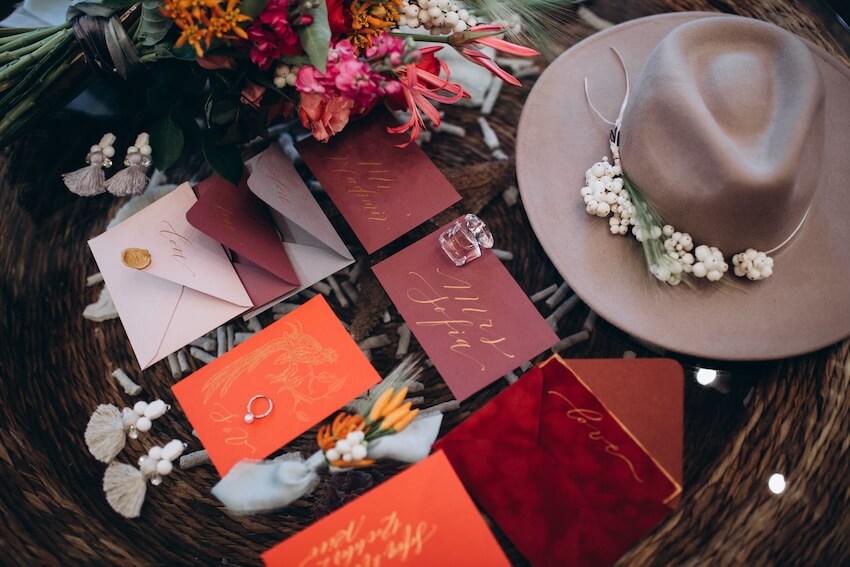
With all these customs in mind, this is your wedding, so you get to make the rules. Your wedding day will be filled with your favorite people from all walks of life — with many different lifestyles and living situations. Think of each individual guest as you write their invitation, considering how they wish to be addressed.
From all of us at Greenvelope, have a wonderful wedding day. The countdown is officially on! If you still need to pick out your wedding stationery, browse our collection of wedding invitations as well as save the dates and thank you cards. Choose from formal wedding invitations with glamorous details or opt for a simple design with understated elegance, whatever you love, there’s a style for you.
Make wedding planning easy by continuing to browse our Stationers blog where you’ll find etiquette advice on everything from wedding invitation wording to fun tips on wedding themes and wowing your wedding guests on the big day.

